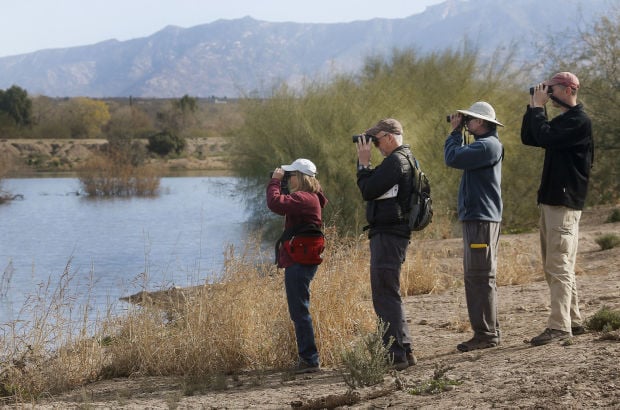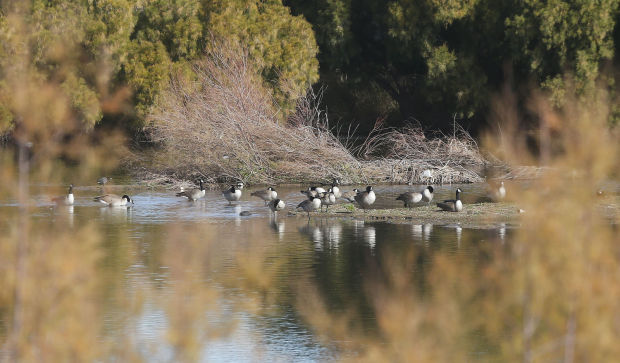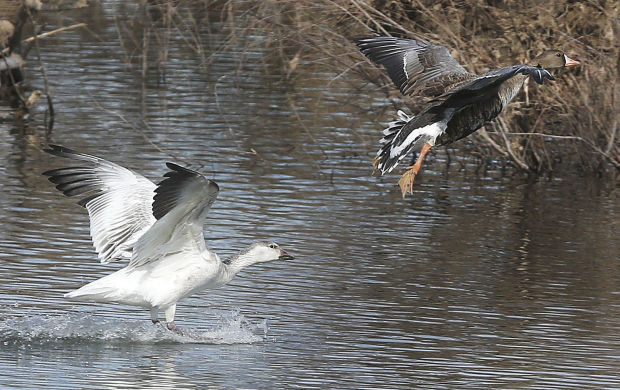The sign in front of a tamarisk tree at the old Coachline Gravel Pit spells out the ground rules:
“Town of Marana property.”
“No off-road vehicles.”
“No dumping.”
“No shooting.”
What could not be banned here was flooding.
And that is how a popular disc golf course along the Santa Cruz River was transformed into a virtual bird sanctuary in a matter of days.
For six years, the Marana Rock Disc Golf Course at the old gravel pit site was a symbol of how a town government and a committed group of recreationists could join forces to make a dream come true. The golfers got rid of illegally dumped furniture, empty oil drums, tires and refrigerators. They erased off-road vehicle trails, built metallic disc golf holes and fashioned steps from old railroad ties so people could easily walk downhill to the course site, which the town of Marana owns.
Adjoining the huge Continental Ranch subdivision near Twin Peaks Road, the 80-acre course was not only one of the biggest and best of its kind in the state. It also had a national reputation, hosting tournaments and drawing championship players from around the country, giving Tucson a reputation as a hot spot for the game that features a disc slightly smaller around than a traditional Frisbee.
Today, most of the course is submerged. Floodwaters, which routinely pour into the pit site for a couple months in monsoon season, roared in last September and ripped a huge gap in a large earthen berm separating the course from the Santa Cruz.
Now, the course is an urban lake, near the scale of others in the region such as the Kennedy Park Lake on Tucson’s south side and Silverbell Lake on the northwest side. With floodwaters long departed, the treated sewage effluent that normally rolls down the Santa Cruz continues coursing through the lake.
The lake has become a second river channel, separated from the main river by a 25- to 40-foot-wide, sandbar-like spit covered with tamarisks, willows, rocks and gravel. There’s no sign the water will ever go away.
Unlike many of Tucson’s non-native lakes, this one is ringed by native mesquite and palo verde trees and non-native tamarisks. Islands and spits and sandbars in and around the perimeter are covered with grasses and tamarisks.
The lake is drawing birds in droves. Dozens of swallows, hundreds of ducks, flocks of Canada geese, numerous flaming red vermilion flycatchers, herons, egrets, sandpipers — seemingly everything in this region that likes water — are calling this place home. A highlight is a fairly uncommon greater white-fronted goose that pals around with a snow goose — birders call them “the odd couple.”
The birds are drawing increasing numbers of happy birders, who compare this lake favorably to the Sweetwater Wetlands in Tucson, long considered the urban area’s primo birding site. The golfers are disheartened.
Rare birds abound
As he walked down the slight downhill slope toward the lake on a recent sunny morning, professional birding guide Laurens Halsey called this probably Tucson’s best area for birds at the moment.
“It just happened that a dozen rare birds have shown up here,” said Halsey, of Green Valley, who serves as a volunteer reviewer of all submissions of Pima County bird sightings for the ebird website, which charts bird sightings nationwide. A prodigious bird-finder, he spotted 413 species in Arizona last year.
His companion, Marana birdwatcher Andrew Core, who lives seven minutes from this site, observed that more than 100 swallows of various species were sitting on a nearby power line earlier that morning. At least 40 rough-winged swallows, 30 tree swallows and three bank swallows were on hand — and bank swallows are extremely rare in Arizona.
“Normally, swallows are not common in Arizona in the winter,” said Core, a missionary for a nondenominational group, who reviews ebird sightings reported from Santa Cruz County. “Usually the tree swallows are gone by October and back by late January. This year, they just stayed.”
Ranking the Tucson area’s most prolific birding sites by species count, Coachline has a ways to go. It is 105 species behind the top-ranked Sweetwater Wetlands’ cattails and reeds. But since Christmas, about 110 bird species have been reported to ebird from both spots, Core said. With more birders flocking to Coachline, the number of reported species should grow, he said.
Rarities seen at the site have included a dickcissel, a black vulture, an eastern phoebe and a tricolored heron, the birders said.
Walking toward the Santa Cruz, Core, Halsey and a third birder, Bill Harris, talked of all the work the disc golfers had done to spruce up the pit area — which had been used back in the 1950s by the Arizona Department of Transportation to build Interstate 10 to the east.
“I feel for them,” Core said. “They’ve made it better. There’s less shooting, less vandalism, less dumping. There’s more people to keep an eye on things. This is not about birders vs. golfers. I hope they can find another place to play.”
Walking further east, the birders spotted three snowy egrets nearby. An American pipit walked on a mudflat next to a tamarisk. A green heron — “the American Birding Association’s bird of the year,” Halsey observed — preened on the base of a small island near a dead tamarisk. An immature black crowned night heron stood at the water’s edge.
Course highly ranked
Looking at the same spot a few days later, disc golfer Chad Miltenberger said the void in the berm “used to be a little break. Now it’s a football field away.
“Usually in October or November, we get the course back. In the meantime, we use a temporary course on the perimeter. Now, we’ve become part of the Santa Cruz. It comes in at hole 17 and exits at hole 11,” said Miltenberger, president of the Marana Disc Golf Club.
After disc golfer Mike Anderson was approached about the idea of a Marana golf course by a fellow golfer back in 2006, a group spent time planning, politicking with town officials and doing some intensive cleanup before installing the first nine metal baskets in 2008 and the rest in 2009.
“That area had been used for wildcat dumping, paintball wars and illegal off-roading. It literally was a dump,” recalled Anderson, who now lives in Woodland, California, north of Sacramento. “The town was worried about liability, and we made the perfect fit for the town. We provided the labor and drove out all the bad influences.”
Just last year, a national tournament was held at the site, the fifth annual Lockdown tourney, drawing 90 players from five or six states, said Miltenberger, a physical therapist. It was sanctioned by the national Professional Disc Golfers Association, which now manages a game that started in California in the 1960s.
Most people who play here regularly rank this as one of the top five courses in a state of 42 courses, including five in Tucson, he said. In 2012, a world champion disc golfer, Paul McBeth of Huntington Beach, California, played there.
“We’re definitely disappointed that we lost such a beautiful course, but Marana Parks and Recreation, they’ve supported us all the way through,” Miltenberger said. “They’re working with us to find land to bring us a new course.”
As for the birders, Miltenberger said, “Good for them. I have no hard feelings.
“It’s a little depressing, but we do what we can with what we have.”
Future of Course bleak
As Marana’s parks director sees it, the odds of the course returning to normal are very low.
Fixing up and bolstering the berm, most likely with concrete or soil cement, would require permitting because the lake adjoins the Santa Cruz River. Construction in and around it is federally regulated, meaning the town would need a permit from the U.S. Army Corps of Engineers, which can take months and sometimes years to obtain.
“Engineering along the berm would be incredibly expensive. It would be outrageous for us to do that,” said Parks and Recreation Director Tom Ellis. “It’s kind of like remodeling your house. Bringing the berm up to code would be a lot more expensive than building the earth berm up there now.”
If someone were to engineer the berm well enough to take the golf course out of the floodplain, the property would be so valuable it probably would be developed, he said.
Ellis said he’s holding meetings with volunteers for the disc golf community to hunt for other locations for a course, probably a smaller one.
“Disc golf is a great recreational pastime,” he said. “For a little money, you get a great recreation return. We’re by no means closing the door on disc golf, or on folks who enjoy watching wildlife.
“We’re just waiting to see what the water does.”






